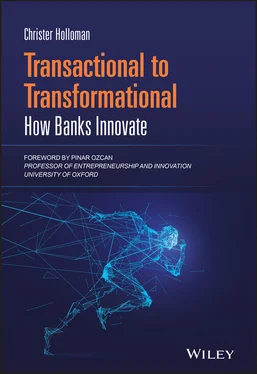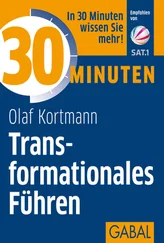LBG aimed to deliver this transformation agenda whilst maintaining their cost‐to‐income ratio. As such, the group recognised the importance of utilising every available transformation lever.
Internally, the group brought the end‐to‐end change functions into a single area called Group Transformation. The function was organised into value streams aligned to customer journeys and an increasing amount of change began to be delivered using agile principles and practices. Additional transformation enablers such as Design and Data Science were also scaled up with the aim of delivering more customer‐focused change, whilst lowering the overall cost of change.
However, as they looked across the industry, there was an external lever that other banks appeared to be increasingly using that did not play a big role in their change and innovation toolkit at the time: working closer with fintechs.
They saw a lot of examples of banks and insurers announcing either direct partnerships or investments. Within Lloyds, the Group had interacted with the fintech ecosystem through various industry initiatives or incubators but without any material commercial outcomes, so they set out to understand the opportunity better. Firstly, could fintech partnering be a relevant delivery route for innovation across LBG? Secondly, if it could, then why had it not emerged organically to date?
By mapping external innovation activity against LBG's strategic agenda, they found sufficient evidence to support two delivery goals. Firstly, the opportunity to accelerate or enhance their technology transformation agenda, especially where that leveraged emerging technologies. Secondly, the opportunity to ensure they were able to provide best‐in‐class products and services to their customers, especially where this stretched beyond traditional balance sheet products.
On the second point, they found evidence of several friction points that collectively pointed to the need to develop a specialist set of capabilities, processes and culture in order to enable them to fully benefit from this opportunity. They needed to enhance the ‘rails’ on which partnering opportunities could run, meaning the journey right from opportunity identification through to execution. For example:
There was no consistent way of monitoring or segmenting the fintech landscape to support opportunity identification.
There was no consistent approach to help to surface business needs that would benefit most from partnering solutions.
Some elements of their policies added out‐sized friction to conducting proofs of concept with third parties.
In some places their technology capabilities made integration with third parties more challenging.
There were few established routes through which to surface promising innovation partnering opportunities to an adequate level.
There was no existing framework for considering strategic investments in partners at this scale.
Their traditional corporate development activity had focused on relatively large‐scale acquisitions and disposals, where the value was primarily in the existing balance sheet as opposed to a primarily IP and growth‐led approach.
Crucially, at the same time this discussion was taking place, one specific opportunity had been identified by a group of senior colleagues within the technology team. This related to a fintech called Thought Machine, which was developing a cloud‐native next generation banking platform. This provided an ideal pathfinder project and helped to illustrate the broader opportunity within the group.
‘We invest in fintechs who have the potential to really help deliver improvements to the business and service to customers. The more core these solutions sit in our architecture and customer service proposition, the more we consider taking equity stakes.’
Zak Mian, Group Transformation Director
A working group was formed between the central innovation and corporate development teams in order to design solutions for the identified gaps across the end‐to‐end partnering journey: from idea to execution. The team began by developing a framework for enhancing fintech partnering along key stages of the process.
Their initial steps were to create a shared definition of the key stages in the partnering process. Whilst they identified differing numbers of steps in use across industries, the overall process was similar. They opted for a five‐stage process, leveraging definitions already in use in one area of the bank. All those definitions relate to partnering opportunities for a specified business need:
Identify. A long list of relevant fintechs has been identified.
Assess. A selection has been made for a preferred potential partner (typically an initial desktop exercise to form a shortlist and then more detailed interaction with the remaining parties).
Engage. Initial experimentation with the potential partner to test the target partnership solution is being developed or is underway.
Advance. Deployment of the partnership is planned at scale, including a final partnership structure.
Breaking down these processes into these stages enabled them both to build up a cross‐group pipeline view and would provide a way to structure potential solutions to the gaps they had identified.
As with many innovation processes, they understood that for each successful partnership reaching the advance stages, many more would need to have been explored and ruled out earlier in the process. Therefore, it was critical that they sourced adequate opportunities from across the bank.
The first step would be to create business‐sponsored innovation working groups for their main transformation lines: Retail, Insurance, Commercial and Enterprise (RICE). Each working group would consist of product‐level representation, typically from business development, strategy or innovation roles. The working group would become a route through which to disseminate best‐practice in terms of fintech scanning, selection and partnering. In addition, additional tooling would be made available to the groups to enable them to execute these activities. For example, access to a central fintech hub was distributed as a way to identify and monitor relevant fintechs across the group, while also providing divisional and group‐level data to support decision‐making. The working group approach would also provide a way to identify gaps in activity relative to a designated baseline.
Another part of the solution would be to develop a collective understanding of the characteristics of a robust innovation partnership. This would centre on being able to prioritise business needs for which a fintech partner solution had the potential to add the most value relative to a build solution. This would begin by leveraging their initial analysis, but would quickly become enhanced by evidence and experience. At the same time, before selection opportunities to prioritise, they would also need to consider the expected complexity of pursuing them. The netting out of these two characteristics would help to determine which opportunities would be prioritised.
Importantly, they recognised that the complexity of partnering was not a fixed thing. Rather it was something they could aim to improve over time and thereby potentially increase their opportunity space. As such, they would continue to investigate technological and non‐technological opportunities to make partnerships easier to deliver, whilst still achieving appropriate levels of safety and security.
At the advance end of the process, they would utilise their pathfinder opportunity alongside non‐fintech partnership experience to inform their approach to partnership structuring. A key element of this was consideration of equity investments. Where there was an opportunity to invest, they decided on two core principles that would need to be met. Firstly, they would only consider investing in companies with whom they expected to form a commercial agreement or had done so already. Secondly, there would need to be a very clearly defined strategic benefit of taking equity, relative to what was achievable through a commercial contract. Their initial appetite was also focused on minority investment stakes only, due to the additional consolidation considerations typically associated with larger positions. It was at this point in the process that they would utilise their pathfinder opportunity to begin building some of the specific capabilities required for fintech investing.
Читать дальше











